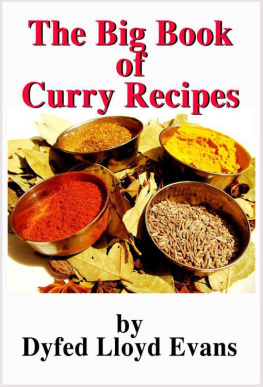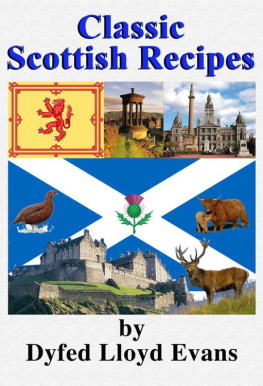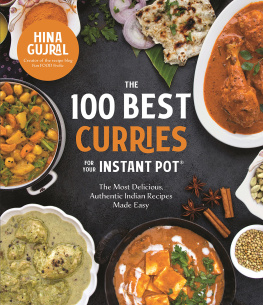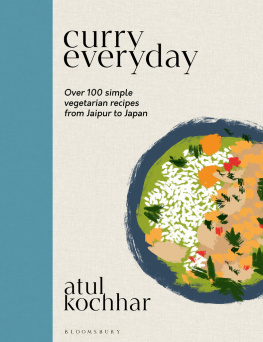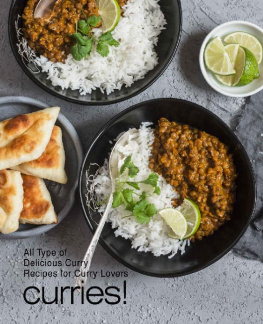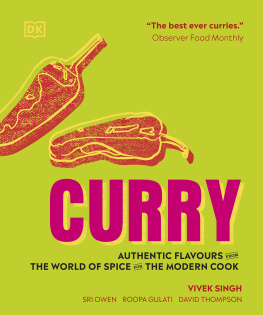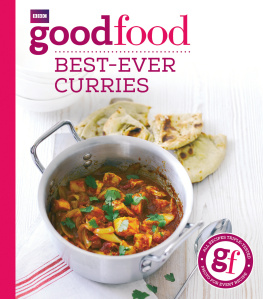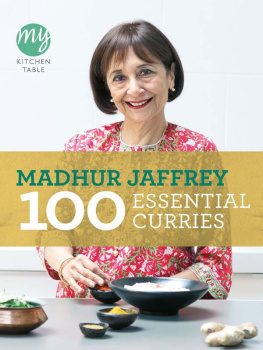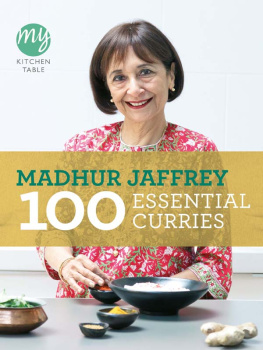
The Big Book of Curry Recipes
by Dyfed Lloyd Evans Table of Contents.


Introduction. Introduction to Curries
The world of curry is a huge one. Indeed, the term has expanded dramatically from its use to describe various dishes with a spice base (whether dry or with a gravy) cooked in the Indian sub-continent (primarily India, Pakistan, Bangladesh and Sri Lanka). Indeed, today the term curry (in the West at least) is used to denote a huge range of dishes typically derived from Indian, Pakistani, Bangladeshi, Sri Lankan, Thai and other South-East Asian cuisines that typically employ a combination of spices and herbs for flavouring and which also, frequently contain fresh or dried hot chillies. The term curry is commonly believed to be an anglicized form of the Tamil word kari , literally meaning sauce, but which is typically understood to mean vegetables and/or meat cooked with spices with or without a gravy. This type of cooking was first encountered in the mid 17th century by members of the British East India Company trading with Tamil merchants along the Coromandel Coast of southeast India.
They became familiar with a spice blend used for cooking these dishes called kari podi (curry powder). It should be noted however, that the traditional pot cooking these dishes is known as a karhai.
Indian traders brought these cooking techniques to East Africa and curries are now an integral part of Swahili cuisine. Indians also brought curries to Malaysia and Singapore. When the British brought Malays to work in South Africa they also brought their curries with them. There are also large Indian populations in the Caribbean and curries of various kinds are popular on many of the islands. Of course, we all know the story of the Tikka Masala, the cream-based curry invented in Britain and then there is Coronation Chicken.
Elsewhere the idea of a curry powder has been re-invented for local tastes and local ingredients (particularly in South Africa and West Africa) so there are native curries emerging there. It should be noted, though, that the curry powder that denotes the commercial powder sold in the West today is not an authentic Indian notion. Though curry powders (masalas) are made in India, they are always made at home from a blend of whole spices. Indeed, the curry powder as we know it was invented in the 18th century by Indian merchants who sold it for sale to members of the British Colonial Army returning to Britain. This led to the evolution of curry powders in Victorian London which were heavy on turmeric and which sought to capture the essence of those powders brought back by the colonial soldiers who demanded the Anglo-Indian food they had become accustomed to when they returned to Britain. This led to famous curry powders such as Col Whites being sold on the mass market.
Origins and Spread of Curries Archaeological evidence (from 2600 BCE) suggests that even in prehistoric times dishes of highly-spiced meats were prepared by the inhabitants of the Indus Valley. Mortars have been found that were used to pound spices that included mustard seeds, fennel, cumin and tamarind seeds. The writings of the Vedic Period (1700 to 500 BCE) also indicate that these dishes continued to be prepared. During the 7th century CE, Buddhist monks took the spiced dishes of India eastwards to Burma, Thailand and as far as China. At about the same period, coastal traders (particularly those plying the spice trade) carried the style of cooking eastwards to Indonesia and the Philippines and westwards to East Africa. During the 16th century, the Mughal Empire was established in northern India and the Muslim rulers brought with them Persian spices and Islamic cooking practices that transformed the earlier Indian styles of cookery.
The Portuguese established a trading post in Goa in the early 16th century and they brought with them their own cooking practices (particularly pork dishes) and, more importantly, they introduced chillies to the Indian sub-continent. Curries began to establish themselves as part of British cuisine from the mix 18th century, with the establishment of the Raj. This Indian cooking style became popular in Britain and by now has established itself as a staple of British cookery. Indeed, curry styles invented in Britain are now making their way to India. It was also the British who introduced curry as a cooking style in Japan. During the 19th century, curry was brought to the Caribbean by indentured Indian workers who were transported there to work on the sugar plantations.
Since the 1970s curry, as a style of cooking has become popular worldwide indeed, it is a cornerstone of modern Fusion cookery. About this Book: The core of this book is about traditional curries and curry powders, also Indian and Pakistani starters, breads and side dishes, everything you need for an authentic meal. But I am an inveterate collector of recipes from around the world and I travel to Africa often, so there is a large collection of African curries here. I have also collected some of the recipes and secrets from Indian restaurants and present these restaurant-style curries in this book as well. In addition, there are several dishes from east and Southeast Asia that also fall into the curry category (most particularly Thai dishes). The real secret of curries, of course, lies in the spices.
And the aroma and flavour of spices are dependent on various aromatic compounds and essential oils found within them. Wherever possible buy fresh spices. If you cannot do so then by whole spices and grind them at home as you need them (whole spices retain their aroma profile much, much, better than pre-ground). Pre-ground spices may be very convenient, but because they have been rendered to a fine powder, they lose their subtle aromas very quickly. For the most part, I have tried to keep these recipes to spices that are easily obtained, or at least can be bought on-line from specialist suppliers. However, in preparing this book I have amended that condition a little after all, I live in a small northern town and even my local supermarket now has fresh turmeric, a range of chillies and fresh curry leaves available.
In Britain, the first recorded curry recipe comes from Hannah Glasses 1747 volume: The Art of Cookery made Plain and Easy and I include that recipe in this volume. Eliza Acton in her 1845 book, Modern Cookery also had a number of curry recipes and I include them here. Her curry recipes led to game (particularly game fowl) recipes being popular in Anglo-Indian cookery (pheasants and peacocks are native to India) and I include on of those recipes for leftover game birds in this volume. In India, curries are typically cooked in a double-handed steel pan similar to a wok called a karhai. You could substitute a wok, a skillet or a large stockpot. I started collecting curry recipes in the 1980s when I moved to London.
Since then, I have still been collecting and cooking curry recipes. I also have a passion for historic recipes, so that the recipes given here, though mostly traditional Indian and Pakistani dishes recipes from the 1890s to the 1920s that are classic examples of Anglo-Indian cookery are also represented. Curry is a broad church and this book aims to show the whole spectrum of the art. I have also been collecting recipes from restaurants, so this book also gives you some of the methods and tricks involved in making restaurant-style curries. But the book is not just about curries. After all a curry is part of a meal, so you will also get recipes here for flatbreads and pancakes, rice dishes, pickles, chutneys and sambals as well as traditional drinks that typically accompany a curry meat.
Next page
